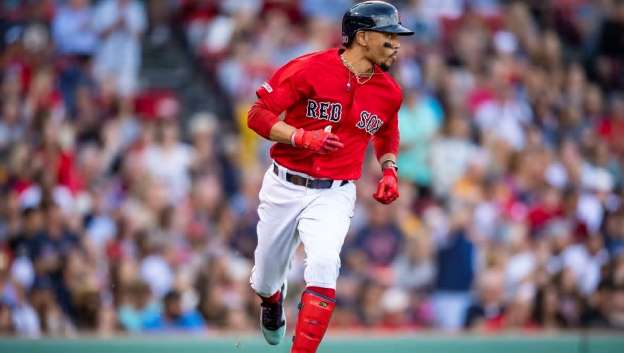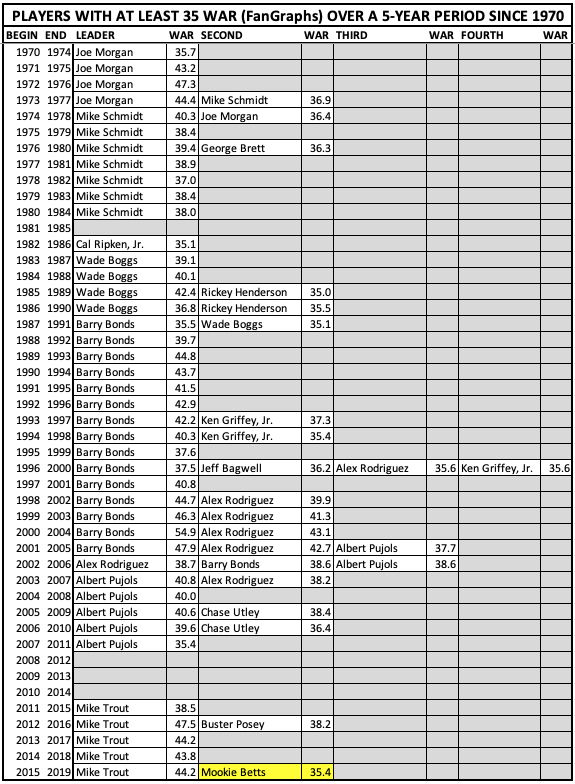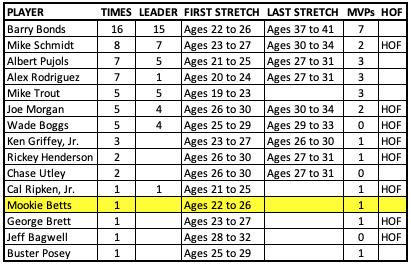Red Sox Mookie Betts Trade Is Unprecedented

After much speculation this offseason, word came out last week that the Boston Red Sox finally did, in fact, trade Mookie Betts. And then it turned out they didn’t, at least not as of writing, but they still might. While we wait to see what ultimately happens with the blockbuster Mookie Betts trade, it’s interesting to consider just how unprecedented it is for a player as good as Betts to be traded at such a young age.
When the rumors first started, it seemed unfathomable that a team would trade one of the best players in baseball, especially a team with the financial clout of the Boston Red Sox. Last season, the Red Sox averaged 36,107 fans per game in a stadium with a capacity of 37,731, so their average attendance was nearly 96 percent of capacity. Not only does the team draw incredibly well, they also make plenty of money through concessions, TV contracts (both local and national), and licensing agreements and sponsorships. According to Statista.com, the Red Sox were were purchased for $380 million in 2002 and are now valued at $3.2 billion. They didn’t (don’t?) NEED to trade Mookie Betts.
If the trade goes through, one of the best players in the game is headed to Los Angeles to play for the Dodgers. Over the last five years, the only player with more Wins Above Replacement (WAR, per FanGraphs) is Mike Trout. Not only is Betts among the best players in the game, he’s also quite young, having just finished his age-26 season.
Betts made his major league debut in 2014, when he played in 52 games and hit .291/.368/.444. In a little less than one-third of a season, he was worth 1.8 WAR, which is about a 5.5-WAR pace over a full season. In his five full seasons from 2015-2019, he accumulated 35.4 WAR. This includes his monster 2018 season (10.4 WAR) that earned him the AL MVP Award. He also received MVP votes in each of the other four seasons.
To get an idea of just how good Betts has been over the last five years, I looked at how often a position player earned 35 WAR during a five-year stretch over the last 50 years. Since 1970, just 15 players have accomplished this feat. Here’s a handy chart to consider:

The 1970s and first half of the 1980s were dominated by Joe Morgan, then Mike Schmidt. Morgan earned at least 35 WAR during five straight five-year periods as a perennial all-star and Gold Glove-winning second baseman. He won back-to-back NL MVP Awards in 1975-1976, right in the middle of this stretch of dominance. Schmidt accomplished the feat eight straight times. He also made the all-star team almost every year, won five Gold Gloves, and earned back-to-back NL MVP Awards in 1980-1981.
During Mike Schmidt’s run, George Brett had a five-year stretch from 1976 to 1980 during which he earned 36.3 WAR. He was an all-star all five of these seasons and won the AL MVP Award in 1980. That was the year he flirted with .400 well into September and was the story of baseball. He ultimately finished with a league-leading .390 average and also led the league with a .454 on-base percentage and .664 slugging percentage.
No position player reached the 35-WAR mark from 1981 to 1985. This was due at least in part to the 1981 strike that wiped out about one-third of the season. Had the season played out, it’s likely Mike Schmidt would have accomplished the feat an additional time.
Cal Ripken, Jr. makes the list for his 35.1 WAR during the five-year period from 1982 to 1986. This included his AL Rookie of the Year season in 1982 and his AL MVP season in 1983.
Wade Boggs had a Joe Morgan-like stretch in the mid-1980s when he earned at least 35 WAR during five straight five-year periods. Like Morgan, Boggs led baseball in five-year WAR four times and was second once. He didn’t win any MVP Awards, but did lead the AL in batting average five times and on-base percentage six times.
When Boggs was finally surpassed in five-year WAR during the 1987-1991 period, it was Barry Bonds who knocked him out of the top spot. This was young Barry Bonds, when the svelte outfielder was still playing for the Pittsburgh Pirates and averaging 25 homers and 35 steals per season. From the late-1980s to the early 2000s, he reeled off 16 consecutive five-year periods with at least 35 WAR, leading baseball in 15 of them. He first achieved the feat from the ages of 22 to 26 and did it one final time from the ages of 37 to 41. He was easily the oldest player to accomplish this. Along the way he earned eight Gold Gloves and seven NL MVP Awards.
While Bonds was dominating baseball throughout the 1990s and early 2000s, a couple other players popped up on the list of guys who had at least 35 WAR over a five-year period. Ken Griffey, Jr. did it three times in the late-1990s and Jeff Bagwell did it once. Both achieved the mark, along with Bonds and Alex Rodriguez, in the 1996-2000 time period. No other five-year period had four players reach at least 35 WAR.
Speaking of Alex Rodriguez, he made the list seven times, but was the top guy just once because he had the misfortune of playing in the Barry Bonds era. While Bonds was dominating the National League, Rodriguez was dominating the American League. He was a perennial all-star during this stretch, leading the league in home runs five times, winning two Gold Gloves, and three AL MVP Awards. Rodriguez finally led baseball in five-year WAR from 2002 to 2006, when he finished just ahead of Bonds and rising star Albert Pujols. He was then immediately surpassed by Pujols in the 2003-2007 period.
Pujols made the list twice behind Bonds and Rodriguez before becoming the leader in WAR over five straight five-year periods that ran from 2003 to 2011. He won three NL MVP Awards during this stretch and finished second in MVP voting four times and third once. Pujols is one of six players, including Mookie Betts, who accomplished this feat by age 26.
During Albert Pujols’ run of dominance, only one player other than A-Rod pops up on the list—Chase Utley. The Phillies second baseman had 38.4 WAR from 2005 to 2009 and 36.4 WAR from 2006 to 2010. This coincides with Utley finally getting regular playing time at the age of 26 in 2005. Once he became a full-time player, he was an all-star every year from 2006 to 2010 and received MVP votes in four of those seasons.
When Pujols went into his decline after signing as a free agent with the Angels, no player immediately stepped up to take the crown. In the three five-year periods between 2008 and 2014, no position player accumulated 35 WAR. Miguel Cabrera (33.6 WAR) came close in 2009-2013 and again (33.7 WAR) from 2010-2014, but didn’t quite get there.
The drought ended when Mike Trout took over as the King of WAR. He first accomplished the feat in the 2011-2015 period and is now going on a five-year run of leading baseball in WAR over five-year periods. This puts him in elite territory with Bonds (15-time leader), Schmidt (7 times), and Pujols (5 times). Trout became the youngest player since 1970 to accomplish this when he earned 38.5 WAR from the ages of 19 to 23.
Early in the Mike Trout era, Buster Posey pops up on the leaderboard for his 38.2 WAR from 2012-2016. During this stretch, he was an all-star four times and the NL MVP in 2012. Mookie Betts joined the group at the conclusion of last season. He earned 35.4 WAR from 2015-2019. This included his AL MVP season of 2018, along with four all-star seasons and four Gold Glove Awards.
The leaderboard of players who earned at least 35 WAR during a five-year period is an impressive roster of talent. They are MVPs and Hall of Famers; they are the best of the best. Nine of these players have appeared on the Hall of Fame ballot and eight of them have been inducted (only Barry Bonds hasn’t). A-Rod may face the same fate as Bonds, but Pujols is a sure-fire first-ballot Hall of Famer. That leaves Chase Utley, who won’t be on the ballot until 2024, but has a good case for the Hall of Fame, and still-active players Buster Posey, Mike Trout, and Mookie Betts.
The following chart shows the details on these elite players.

Players this good and this young don’t get traded
Setting Betts aside, of the remaining 14 players listed above, six played their entire careers with the same team (including active players Trout and Posey) and four left their original teams as free agents. That leaves four players who were traded. One of those, Chase Utley, was traded long after his peak, as he was dealt to the Dodgers during his age-36 season. That’s not a great comparison for the Betts trade because Betts is 10 years younger.
That leaves three players on this list who were traded while they were at or near their peaks. Joe Morgan was part of an eight-player trade in November of 1971. He was coming off his age-27 season with the Astros and would immediately become an MVP candidate with the Reds. At the time of the trade, though, Morgan wasn’t yet the superstar he would become and the Cincinnati Enquirer panned the deal. Reporter Bob Hertzel didn’t approve of the Reds trading away Lee May and Tommy Helms. He wrote, “If the United States had traded Dwight Eisenhower to the Germans during World War II, it wouldn’t have been much different than sending (Lee) May and (Tommy) Helms to Houston.”
Hertzel turned out to be (incredibly, catastrophically, gloriously) wrong about this trade. The Reds made it to the World Series in 1972, losing to the A’s, then won back-to-back World Series titles in 1975-1976. Morgan was the engine that powered The Big Red Machine. Of course, the Morgan trade was before free agency, so it’s also not the best comparison for the Mookie Betts trade. The Astros weren’t going to lose Morgan to free agency in a year.
Rickey Henderson was traded during the 1989 season, just a few months from free agency. He was among the best players in the game, like Betts, but was four years older and was playing in his eleventh major league season. Henderson had already been traded once in his career—by the A’s to the Yankees after the 1984 season. Given the circumstances, the Henderson trade is not a good comparison for the Mookie Betts trade either.
Perhaps the best comparison would be when Ken Griffey, Jr. was traded by the Seattle Mariners to the Cincinnati Reds after the 1999 season. Griffey was coming off three straight seasons in which he led the AL in homers. One of those was his 1997 AL MVP season. He’d also finished in the top-10 in MVP voting six other times during his Mariners career at that point. He was a perennial Gold Glove winner and a franchise icon who had one year left on his contract.
Unfortunately for Seattle, the franchise icon was disgruntled in the Emerald City. He demanded a trade in November and had ten-and-five rights that allowed him to veto any deal. It was no secret that he wanted to play in Cincinnati, where his father had played. The Mariners accommodated him with a trade to the Reds that brought back Mike Cameron, Brett Tomko, Antonio Perez, and Jake Meyer.
At the time, the Mariners were blasted for what was considered a paltry haul for a superstar. At the Sporting News, Michael Knisley wrote that the Mariners “got fleeced last week more completely than Bo Peep’s lost sheep at shearing time. For Junior Griffey, the man most likely to break Hank Aaron‘s all-time home run record, the game’s most perfect all-around player in the prime of his career, the Reds gave Seattle … bits and pieces, drips and drabs of major leaguers and wanna-bes.”
Once again, the initial criticism was quite wrong. Griffey had a good first season with the Reds (5.4 WAR), but struggled to be a league average player from that point forward. He hit well enough to ultimately surpass 600 homers, but injuries and a significant decline on defense hampered his value. From 2000 to 2003, he was worth 8.9 WAR. In that same time period, Mike Cameron was worth 19.9 WAR. The Mariners easily won the Ken Griffey, Jr. trade from a baseball perspective, even while losing the public perception battle.
The Griffey trade was similar to the Betts trade, but still not a perfect comparison. Griffey was an 11-year veteran, was three years older than Betts is now, and was demanding to be traded. None of that is true with Betts. The Red Sox aren’t forced to make a Mookie Betts trade deal. They’re choosing to trade away one of the best players in the game in the middle of his peak. It’s a move we haven’t seen a team make with a player this good and this young in at least the last 50 years.
-Bobby Mueller












